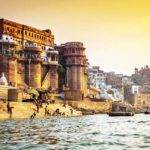About

Our Emblem
‘The Sailboat’ company’s emblem symbolizes the empirical journey of the spirits into the untraveled waters of Art, History, Culture and Civilizations of the chronicle past.
The Invigorating journey is filled with experiential delights and enthralling experiences that tunes in harmony with the invincible Zest, Faith and Desire of the travelers aboard and going way to the perfect ecstasy.
About Us
‘Holy Waters India Journeys’ is an approved ‘Inbound Tour Operator’ by Ministry of Tourism – Government of India, managing touristry at major off-beat destinations of ‘Uttar Pradesh’ particularly sightseeing tours in Prayagraj, Kaushambi, Jaunpur, Chitrakoot, Chunar, Mirzapur and Bundelkhand etc.
The Company specializes in rendering state of the art travel solutions to its Guests (Foreign Nationals) based on the modern day concept of Concierge.
Located at the banks of Ganges the company has a deep-rooted network of experienced and dedicated squad of Travel Professionals & Local Guides across the state who excel in providing one-of-a-kind sightseeing services with all of the breathtaking and leisurely tour experiences that the area has to offer.
Our Interpretation
‘Holy Waters’ is more a philosophy rather than a mercantile setup that aims at enriching human relevance by means of Travel & Tourism.
The company by virtue of its brand name ‘Holy Waters’ grails at making tourism innovative, unique, authentic and futuristic in line with effective sustainable practices, service value and visitor experience assessments.
HW interprets tourism through experiential tours and journeys accoutered with a niche range of products that dart in accordance with the current tourism trends and scenarios in vogue. The thought focuses upon creating memories by notion of experiential visits that connects people with the Heritage, Culture and Community of the intended destination and going far beyond the usual ‘Sun Sand and Sea’…
Our Destination – Prayagraj
Prayagraj a.k.a. Allahabad, sprawled along the banks of the fabled Sangam at the confluence of three divine rivers: the holy Ganges, Yamuna and mythical Sarasvati the Pious city is considered to be the king of pilgrimage centers and the birthplace of Sacred Texts. The city has its significance from ancient era formerly known as “Prayag” (place of offerings) as mentioned in prominent Hindu scriptures such as: Vedas, Ramayana and the epic Mahabharta. As per the popular Hindu belief this is the oldest living city after Kashi (Varanasi) in the world.
History
The archaeological evidence of Prayag is as old as 1100 BCE. The city was anciently called ‘Kaushambi’ by then Kuru rulers of Hastinapur who shifted their capital to Kaushambi when Hastinapur was heavily ravaged by a deluge. Kaushambi was an important territory of the mighty ‘Aryans’ the place where they first settled in calling it Aryavarta or Madhyadesha. Prayag is regarded as the land of acute asceticism and intense devotion where ‘Lord Brahma’ the Hindu creator of universe attended his ritual sacrifice.
The timeline of Prayag is as pristine as waters of holy Ganges from Buddha’s visit in 450 BC to the period of development that was observed during the reign of Great Ashoka. The legends of Allahabad are a testimony to the grandeur and significance of its virtuous past….
In 1575 BC Akbar colonized Prayag and built a massive fort at the banks of river Yamuna in 1583. It was the eternal beauty of ‘Prayag’ that stirred Akbar to term this city as ‘Illahabad’ the city of Allah (in Persian) while later on ‘Shahjahan’ changed it to Allahabad.
The Allahabad fort was captured by the British East India Company in 1798 and in 1801 the city directly came under the control of the then British rule. Allahabad became the principal seat for the Provincial Government of Agra and anon played an important role in the agitation of 1857 uprising.
It was here in Allahabad when in 1858 ‘Earl Canning’ after suppressing India’s first revolt of independence read out Queen Victoria’s proclamation of transferring India’s hegemony to the British crown from the ruling East India Company and declaring Allahabad as the capital of India. It was since this day the British Viceroy became the official chief of the country. Allahabad was the capital of the United provinces from 1902 to 1920.
In 1888 Indian National Congress’s 4th session was held in Anand Bhavan and it was here where the seeds for a separate Muslim nation (Pakistan) were sprinkled for the very first time.
People & Culture
Allahabad has always been an integral part of India’s rich history. Once the capital of the North-Western Provinces the city was an established centre of British Administration & Learning. Allahabad has contributed immensely towards the building of modern day India. The Allahabad University Estd:1887 is prominently known as the ‘Oxford of the East’ has produced end number of luminaries such as: Prime ministers, Presidents, Chief ministers, Chief Justices Senior Lawyers besides several bureaucrats.
“What Eton & Oxford is to English Allahabad is to Hindi”
Allahabad beholds the Literary and Artistic heritage of the country. The Land is attributed to some of the most noted and celebrated literary giants of the 19th & 20th Century.
E. M. Forster: The famous English novelist arrived Allahabad twice during his visit to India in 1912 and also attended ‘The Magh Mela’ or Mini Kumbh which is an annual bathing-fair of Hindus. .
Rudyard Kipling : The legendary English author-poet and Nobel Laureate stayed in Allahabad from 1887-1903 as he worked here as an assistant editor and overseas correspondent for ‘The Pioneer’ newspaper. Kipling was best known for his works like ‘Just So Stories’ and ‘The Jungle Book’.
Mark Twain : The noted American writer-humorist made his visit to Allahabad in 1895 and wrote “It is a town of wide avenues and noble distances, and is comely and alluring, and full of suggestions of comfort and leisure. The bungalows (dwellings) stand well back in the seclusion and privacy of large enclosed compounds and in the shade and shelter of trees.”
Edward Lear : Well-known British artist, musician and poet visited Allahabad in the year 1872 and commented: The paper I wrote on is simply brittle and burning! Tables, chairs and pillows, all too hot to touch!! This was regarding the hot climate of Allahabad and was called a ‘mini inferno’ by the non-natives.
Julia Strachey : Renowned English writer, photographer and model was born in Allahabad (1901). Julia the scion of Strachey family is the grandniece of ‘Sir John Strachey’ the Viceroy of India 1972 who later on became the Lieutenant – Governor of the North – Western Provinces in 1874. The author is best known for her novel: Cheerful Weather for the Wedding (1932).
Kinsey Peile : Born in Allahabad, Peile was a British dramatist/actor who acted in several English silent films like: The Face at the Window, Settled out of Court, The Vortex etc.
Moreover Allahabad is also called as the “City of Prime Ministers” as 7 out of 15 prime ministers of India till date have connections to Allahabad.
Popular and Tourism
Prayagraj is well-known for its Colonial History and Pilgrimage Tourism. The place is world famous for its Ancient Temples, Gothic Churches, Vintage Halls, British Era Mansions and British Cemeteries among international visitors.
‘Prayag’ which is perhaps best noted for its mega event ‘The Kumbh Mela’ is world’s largest pilgrimage gathering that is organized at the span of every 6, 12 years and 144 years. The first written evidence of this epic fair can be traced from the 7th Century accounts of Hiuen Tsiang or Xuanzang Chinese Traveller/Monk who wrote about the Kumbh Mela celebrations during his visit to this holy city in the reign of King Harshavardhana.
Well nothing more can be said about this city a heritage where one would go around the culture and finds that the best of the beauty was lying nowhere but untouched at his backyards…..
